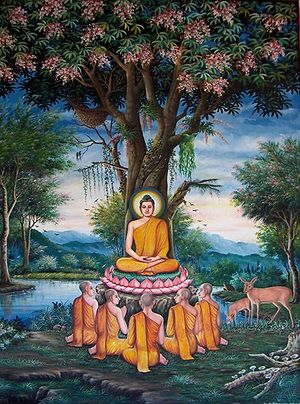My body seems to know when I have weekends off from debate and schedules all my illnesses for those times. Yesterday and today I’ve been fighting a nasty cough and not really feeling motivated to do much of anything. I’m about to take my laundry down in a few, and I went grocery shopping yesterday, but that’s about all I can handle for now.
I’ve been working on my larger project of attempting to find a non-rational, non-propositional justification for academic debate since I can’t do much else but sit around, and I came across the wonderful concept from Zen Buddhism of “skillful means.” What I’ve been researching is the koan (kung-an) as a pedagogical method. What I’ve found so far is that it suggests a rhetoric of teaching and learning quite different from what’s in vogue right now.
Here is Thich Nhat Hanh describing it, in relation to kung-ans:
The kung-an is a useful instrument in the work of awakening, just as a pick is a useful instrument in working on the ground. What is accomplished from working on the ground depends on the person doing the work and not just on the pick. The Kung-an is not an enigma to resolve; this is why we cannot exactly say that it is a theme or subject of meditation. A kung-an is only a skillful means to help a practitioner reach his or her goal. – Zen Keys, 57.
The koan, or kung-an is a tool that helps the student work independently on another problem – the problem of understanding. It is not a thesis, or main idea, or “curriculum.” It’s not a clever intro. I think it is a rhetorical “wedge” that allows the field of “to be understood” to be “mined/mind” (Going with the metaphor here). The metaphor suggests that as a tool it is only as good as the skill of the person who is wielding it. It must be crafted to the particulars of the situation of master/student, then it becomes “merely” skillful means.
So skillful means are a trick? Some sort of clever educational activity? Hanh goes a bit further with it:
To help practitioners cross the river to the shore of awakening, Zen masters hold out the staff of skillful means. But the disciple must grab hold of it. If his eyes remain shut and his mind blocked, the practitioner will miss the staff. (72)
I find this entire discussion fascinating, as it appears to line up with a clearly conservative pedagogy – the blame lies with the student if he or she can’t “grasp the staff of skillful means.” The student has to see it, realize what it is, and grab onto it. If he or she doesn’t, well then, that’s tough. Or perhaps they are not smart enough.
But “skillful means” cuts both ways. The phrase suggests that the means deployed are chosen, refined, calculated, and (most importantly) produced by the master. The master is making a judgement as to what “skillful means” to extend. It is his or her choice, and to extend the exact same means to all students is to fail one’s pedagogical ethic.
A master must know the mentality of his disciple well in order to propose a kung-an that is appropriate. Every master meets success sometimes, but also knows failure when he proposes an inappropriate kung-an. (61)
Clearly the failure is not the student’s all the time. The master must use a “skillful means” that is rhetorically appropriate – it must be recognizable as help for the student. This is the opposite interpretation we get of Zen practice from popular culture, where the master must offer puzzle within puzzle that the student (near the end of the film) recognizes as simple liberal modernism, and finds within his heart the strength to push on toward his uncontroversial quest to eliminate two-dimensional evil from the world (normally with a flying kick).
Negotiation and discrimination are also a part of the rhetoric of Zen pedagogy. If the kung-an is the instrument handed to the student for his or her own labor toward understanding, then the master must be careful not to give it too early or late, and also must make sure the student stays interested long enough to reach the moment of “skillful means.” However, “skillful means” could be extended to describe the rhetoric of the entire master/student relationship, which at first glance appears Hegelian, but I don’t think it fits. There is a different economy at play here, and I think it’s one of the elimination of any fixed points from which one could identify with the opposite term. Instead, Zen masters attempt through “skillful means” the recognition that one is always already “master” and always already “student.” The distinction between the two terms is something that can count as a “skillful means,” but it is clearly the opposite of the goal of Zen practice. This is why Hanh usually uses the adjective “mere” when describing it.
As for debate, do we use “skillful means” to extend assistance to students? Or do we toss one ladder in the water and hope they find it?
Do we take responsibility for the students’ failure to understand, or do we recognize our failure to provide “skillful means” for the topos “to be understood.”
How much time do we waste trying to explain to students “here is the finger, the finger is very important, we must always look to the finger, the finger will show you the way,” when the moon shines brightly just above our head?


